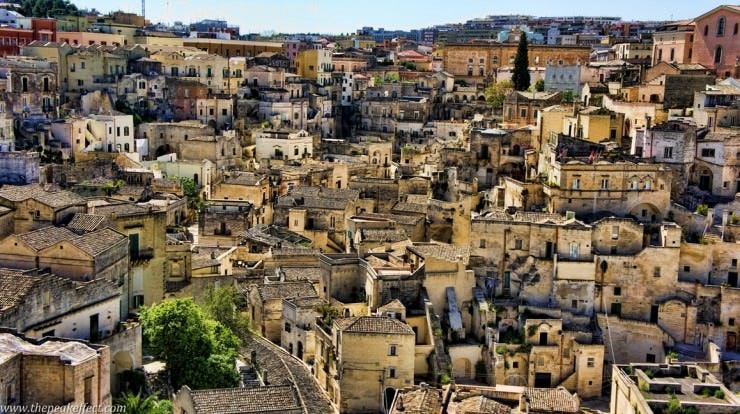magine being a tourist arriving by an underground train station to the busy heart of a big city, taking an elevator out and walking a nice stone paved uphill pedestrian street. 2~3 floors buildings, shops and offices, cafes, terraces, trees, bike lane. You reach the junction on the top of the hill, but instead of the hill top you are at a saddle point: continue straight will take you down, but turning left or right will take you up. You take the turn and face the same options. This is not possible in the Flatland you come from. You look behind and see a distant mesh of streets, a bit like a medieval Italian town on a mountain. You look up and you and far above (tens and hundreds of meters) see hanging gardens above you covering the sunlight. The gardens hang from the streets bottoms and the sunlight is artificial. You are an ant exploring a bush, or more topologically correct, a coral reef.

Astonished, you come to a balcony on an edge of a garden formed around a junction and have a look around. The city is full of life – hanging monorail cars run under the main streets, cable cars are spiraling around the city, public escalators assist in particularly steep streets and public fast elevators stitch the especially busy junctions. For city of these dimensions it is surprisingly quiet as there are no cars at all. Some of the junctions host large public buildings. The houses and the streets are integrated into a single construction, though the houses have their individuality. In the voids between the streets, a strictly horizontal promenade is hung. Far above you you see glimpses of sky, directly above you notice a transparent Olympic pool. In one direction, the mesh of the streets seems less dense, and you go there, hungry for the clear sky. In 15 minutes you find yourself on a street with houses on one side only, and the second side is facing a kilometer diameter well in the city fabric. A kilometer below you is a city park, and particularly luxury streets decorate the walls of the well. You catch the fast elevator to go up, and in a minute you are on the top of the world, walking paths on the houses roofs. You reach the end of the city and take a zip line taking you from 2km height deep into the natural reserve surrounding the 10M megapolis, to sooth your nerves.
Some numbers. For ease of computation, consider streets configuration along the vertices of a diamond like crystal lattice in a [100] orientation, squashed to have 22.5deg inclination, 150m between junctions. The distance to the street directly above you is 300m, occupying 1/5th of the viewing angle. For a 3km high city it there are 10 parallel streets one above another, corresponding to the density of Manhattan finance district. In 1.5km walking distance from you there are ~300km of streets, much like the 270km in a 50mx100m grid of San Francisco. Engineering wise, if 1km sky scrappers are built, why not 1km cube of streets?
Wait, what did we gain? Wall street did that a century ago much cheaper. Manhattan is small. Imagine 10km by 10km of Manhattan. Or sky scrapper Hong Kong. All these city centers are deserted at nights, people don’t really want to be there. What is described above has a feeling of a European old town center, full with business activity and pedestrians, neighbors overlooking the streets and making them safe. The public transportation lives in true 3D, making the city much more accessible, meaning more opportunities in your surroundings available to you – more shops, more kindergartens, more work places.

The environmental implications of dense habitat cannot be overestimated. 10x10km city can be home to 10M people, much like greater London at 1/15th of the land. 10B world population of 2050 fit in 1000 cities scattered across the globe. That is 30 times less than the current global urban sprawl. The streets bottoms can be used for agriculture, providing food heating and light to the city, reducing the crop fields footprint on the planet surface. The efficient electric transportation inside the 3D city with much shorter trails than the 2D city will reduce transport pollution.
The social implications should be fascinating as well. The modern geopolitics is based on land ownership in the military sense. But 10B people cannot be fed from the land anyway, some 3D agriculture will be required, and together with dense cities – land loses it’s strategic value. Sure some objects like mines or factories still remain valuable, but there is no big military interest in protecting vast territories. The very concept of countries is losing it’s meaning, when a single megapolis is as big as a nation. We might see a development of coalitions of cities instead, and a global parliament of mayors. This organization of power might be more suitable for solving global challenges. [I know it is a very loaded paragraph, but benefits of urbanism are not the main point of this post]
3D city poses a technological challenge, but even before that, it is important to plant it into the public imagination by visual means. I myself is very much intrigued to see it with my eyes. A very good modeling can be done by a 3D video game. For example a police vs. crime gang teams catch game in 3D city with jet suite jumps between streets can be entertaining yet simulating orientation and navigation as well as displaying a fascinating world of everyday life in a 3D city.
